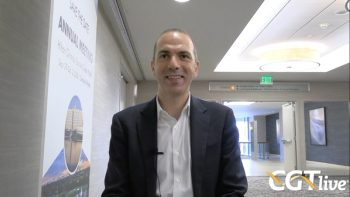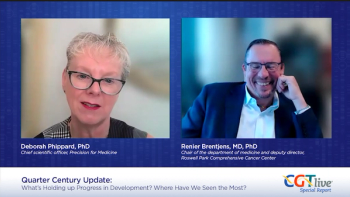
Val-Rox Gene Therapy Restores Factor VIII Production and Reduces Bleeding in Hemophilia A
Complete results from the phase 3 GENEr8 study were published in the New England Journal of Medicine.
Valroctocogene roxaparvovec (val-rox) restored endogenous factor VIII production and significantly reduced bleeding and use of enzyme replacement therapy in patients with hemophilia A, according to complete results from the phase 3 GENEr8-1 study (NCT03370913) published in the New England Journal of Medicine.1
"Breakthrough bleeding represents a high burden of disease management and an unmet medical need for many people. I am encouraged that during the first year of treatment, 90% of study participants had either zero treated bleeds or fewer treated bleeds post-infusion than with factor VIII prophylaxis," first author and principal investigator Margareth C. Ozelo, MD, PhD, director, Hemocentro UNICAMP, University of Campinas, said in a statement.2 "These results reflect the potential for sustained hemostatic bleed control with this gene therapy for hemophilia A."
During the study, 134 participants were infused and completed at least 51 weeks of follow-up. In the modified intention-to-treat population (132 human immunodeficiency virus–negative participants), mean chromogenic substrate factor VIII activity levels during weeks 49 through 52 were 42.9 IU per deciliter (standard deviation [SD], 45.5) and median chromogenic substrate factor VIII activity levels were 23.9 IU per deciliter (interquartile range [IQR], 11.9-62.3). The mean change in factor VIII activity from baseline was 41.9 IU per deciliter (95% CI, 34.1-49.7; P <.001) and median change was 22.9 IU per deciliter (IQR, 10.9-61.3.
In the rollover population of 112 participants from a prospective noninterventional study, mean annualized rates of factor VIII concentrate use after week 4 oftreatment decreased by 98.6%. Treated bleeding decreased by 83.8%, (95% CI, −5.3 to −2.8; P <.001 for both), with a mean change of –4.1 bleeds per year from baseline (95% CI, −5.3 to −2.8; P<0.001). Mean annualized bleeding rate (ABR) decreased by 84.2% for treated joint bleeds, by 85.0% for treated problem joint bleeds, by 81.3% for treated spontaneous bleeds, and by 85.4% for treated traumatic bleeds. Overall, 121 of the total participants (90.3%) had no treated bleeds or fewer treated bleeds after infusion.
“...Further investigation is needed to inform best practices for the prevention and treatment of elevations in alanine aminotransferase levels to optimize transgene expression and minimize the need for immunosuppressants. Moreover, follow-up is critical to assess long-term safety, Courtney D. Thornburg, MD, medical director, Hemophilia and Thrombosis Treatment Center, and director, Hemostasis and Thrombosis Research Program, Rady Children's Hospital-San Diego, and director, Hemostasis and Thrombosis Fellowship Program, and professor, clinical pediatrics, UC San Diego School of Medicine, wrote in a related editorial.3
Ozelo and colleagues found that most adverse events (AEs) were mild (grade 1 or 2). All participants experienced at least 1 AE and the most common AEs included headache (38.1%), nausea (37.3%), and elevations in aspartate aminotransferase levels (35.1%). Serious AEs were reported by 22 (16.4%) patients and 5 of these AEs were treatment-related. Alanine aminotransferase elevations occurred in 115 participants (85.8%) and were managed with immune suppressants. No participants developed factor VIII inhibitors or thrombosis.
Val-rox is developed by BioMarin and has been granted regenerative medicine advanced therapy, breakthrough therapy, and orphan drug designations by the FDA. The EMA has also granted the gene therapy orphan drug designation.
“If approved, this first-generation gene therapy would offer a new choice for care that could be truly transformative and liberating for eligible men with hemophilia. More investigation is needed for children and women with hemophilia and for persons currently excluded because of preexisting AAV immunity, factor VIII inhibitors, liver disease, or HIV infection. Ultimately, highly anticipated gene therapies such as valoctocogene roxaparvovec and others in the therapeutic pipeline will improve the health and well-being of many persons with hemophilia. Health care systems, policymakers, insurers, clinicians, and community partners must prepare the way,” Thornburg wrote.3
The FDA previously rejected BioMarin’s biologics license application for val-rox in August 2020, issuing a complete response letter that cited the need for additional durability data. The FDA requested 2-year follow-up data from the phase 3 study to confirm the durability of the treatment.4
REFERENCES
1. Ozelo MC, Mahlangu J, Pasi J, et al. Valoctocogeneroxaparvovec gene therapy for hemophilia A. New Eng J Med. 2022; 386: 1013-1025. doi: 10.1056/NEJMoa2113708
2.. BioMarin announces publication in New England Journal of Medicine of one-year results from phase 3 pivotal trial with valoctocogeneroxaparvovec gene therapy in adults with severe hemophilia A. News release. BioMarin. March 17, 2022. https://investors.biomarin.com/2022-03-17-BioMarin-Announces-Publication-in-New-England-Journal-of-Medicine-of-One-Year-Results-from-Phase-3-Pivotal-Trial-with-Valoctocogene-Roxaparvovec-Gene-Therapy-in-Adults-with-Severe-Hemophilia-A
3. Thornburg CD. Prepare the way for hemophilia A gene therapy. New Eng J Med. 2022; 386: 1081-1082.doi: 10.1056/NEJMe2200878
4. FDA turns down BioMarin's hemophilia A gene therapy. News release. BioMarin. August 19, 2020. Accessed July 27, 2021. https://www.biospace.com/article/fda-rejects-biomarin-s-hemophilia-a-gene-therapy/
Newsletter
Stay at the forefront of cutting-edge science with CGT—your direct line to expert insights, breakthrough data, and real-time coverage of the latest advancements in cell and gene therapy.











































